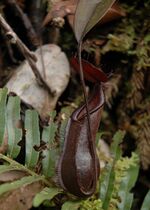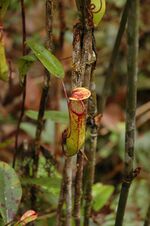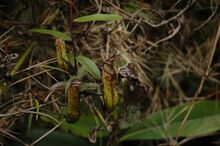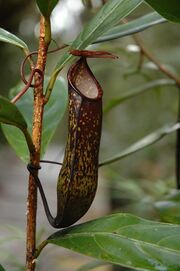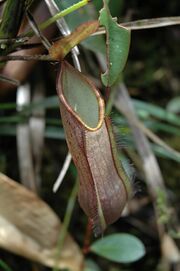Biology:Nepenthes muluensis
| Nepenthes muluensis | |
|---|---|
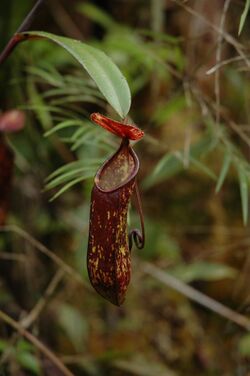
| |
| An upper pitcher of Nepenthes muluensis from Mount Murud | |
| Scientific classification Error creating thumbnail: Unable to save thumbnail to destination
| |
| Kingdom: | Plantae |
| Clade: | Tracheophytes |
| Clade: | Angiosperms |
| Clade: | Eudicots |
| Order: | Caryophyllales |
| Family: | Nepenthaceae |
| Genus: | Nepenthes |
| Species: | N. muluensis
|
| Binomial name | |
| Nepenthes muluensis M.Hotta (1966)[2]
| |
| Synonyms | |
| |
Nepenthes muluensis /nɪˈpɛnθiːz ˌmʊluˈɛnsɪs/, or the Mulu pitcher-plant,[4] is a tropical pitcher plant endemic to Borneo. It grows in highland habitats at elevations of 1700[5] to 2400 m above sea level.[6]
Botanical history
Nepenthes muluensis was first collected by botanist Mitsuru Hotta on March 18, 1964, on Mardi between the third and fourth camps on the western ridge of Mount Mulu, Sarawak.
The holotype, M.Hotta 14791d, is deposited at the Botany Department of Kyoto University (KYO).[7] Hotta described the species in 1966,[2] naming it after Mount Mulu, to which it was thought to be endemic.[4] The description did not cover the lower pitchers of this species, which were unknown at the time.[6] It was the first Nepenthes species to be described in 26 years (after N. densiflora in 1940)[8] and the first since the end of World War II. At this time the genus was experiencing a revival in global interest, thanks largely to the work of Shigeo Kurata.[5]
Nepenthes muluensis has been misidentified at least once in the literature; Bertram Evelyn Smythies identified specimens of N. muluensis as belonging to N. gracillima,[7] a species endemic to Peninsular Malaysia.
This misidentification was published in 1965 in the proceedings of the UNESCO Humid Tropics Symposium, which was held in Kuching two years earlier.[3]
Description
Nepenthes muluensis is a climbing plant. The stem may attain a length of 4 m and is up to 5 mm in diameter. Internodes are cylindrical in cross section and up to 8 cm long.[6]
The leaves of this species are coriaceous (leathery) and sessile. The lamina (leaf blade) is lanceolate in shape and up to 8 cm long by 1.5 cm wide. It usually has an acute apex and is gradually thinned towards the base, extending into an amplexicaul sheath, meaning the base of the leaf is dilated and clasping the stem. Up to 4 longitudinal veins are present on either side of the midrib. Pinnate veins are numerous but indistinct. Tendrils are up to 8 cm long.[6]
Rosette and lower pitchers are up to 7 cm high and 3 cm wide. They are ovate in the lower third, becoming cylindrical or conical above. The peristome, which is the ring of tissue surrounding the entrance to the plant's digestive tube, is approximately cylindrical and up to 5 mm wide. Its inner margin is lined with small but distinct 'teeth'. The pitcher mouth is round to ovate and has an oblique insertion. The lid or operculum is ovate and generally obtuse. It bears a number of filiform appendages (≤5 mm long) on its upper surface.[6]
Upper pitchers are cylindrical for the most part, often with a bulbous basal quarter.[6] Like their lower counterparts, they are relatively small, reaching only 10 cm in height[4] and 2 cm in width. They have a pair of ribs in place of wings.[6] The waxy zone of the inner surface is well developed.[9] The pitcher mouth is round and bears a cylindrical peristome up to 3 mm wide. The lid is orbicular and lacks appendages. An unbranched spur is inserted near the base of the lid.[6]
Nepenthes muluensis has a racemose inflorescence. It is very compact: the peduncle is only up to 3 cm long, while the attenuate rachis reaches 10 cm in length. Pedicels are up to 5 mm long and lack bracts. Sepals are ovate and up to 2 mm long.[6] A study of 120 pollen samples taken from two herbarium specimens (J.H.Adam 2401 and J.H.Adam 2405) found the mean pollen diameter to be 32.0 μm (SE = 0.4; CV = 8.7%).[10]
The species completely lacks an indumentum, with all parts of the plant being glabrous.[6]
The type population of N. muluensis from Mount Mulu has a distinctive pitcher colouration. Lower pitchers are generally dark purple with sparse yellow speckles. The upper pitchers of this form are usually purple with numerous yellowish-white speckles. They often have a white peristome and lid.[5] Plants from Mount Murud produce darker-coloured pitchers.[11]
Ecology
As its name suggests, N. muluensis was originally known only from Mount Mulu. Since its description it has also been found on several other mountains in Sarawak (including Mount Api,[12] Mount Murud, and Bukit Batu Lawi)[5] and one in southwestern Sabah.[13] Nepenthes muluensis has not been recorded from the nearby summit of Mount Benarat, although this is a limestone peak and mostly lies outside the known altitudinal distribution of the species,[6] which is 1700[5] to 2400 m above sea level.[6][14]
Nepenthes muluensis grows in nutrient-deficient soils[15] of the upper montane zone. It typically occurs in open areas of mossy forest amongst ridge-top vegetation.[6] On Mount Mulu, the species seems to be restricted to the western ridge and occurs from an elevation of around 1900 m to the summit at 2376 m. The summit vegetation is greatly stunted, rarely exceeding a metre in height. It is dominated by rhododendrons (particularly Rhododendron ericoides),[16] as well as species of the genera Diplycosia and Vaccinium.[17] Nepenthes muluensis is most abundant in summit heath forest, where it forms dense stands with hundreds of white-speckled pitchers suspended over the sympatric shrubs.[4]
On Mount Murud, N. muluensis grows in shady mossy forest. This population produces darker pitchers than the one from Mount Mulu, possibly due to greater exposure to ultraviolet light at higher altitudes.[11] Two true toad species from Mount Murud, Pelophryne linanitensis and Pelophryne murudensis, are sympatric with N. muluensis and may breed in its pitchers.[18]
The conservation status of N. muluensis is listed as Least concern on the IUCN Red List based on a 2018 assessment.[1] This differs from prior assessments made by the World Conservation Monitoring Centre: in 2000 as Vulnerable[19] and in 1995 as Endangered.[20] In 1997, Charles Clarke informally classified the species as Endangered based on the IUCN criteria, noting that it is Conservation Dependent if populations in protected areas are taken into account.[6]
Related species
Nepenthes muluensis belongs to what has been called the "Hamata group", which also includes four other closely related species from Borneo and Sulawesi: N. glabrata, N. hamata, N. murudensis, and N. tentaculata.[21] More recently, N. nigra has joined this group of related taxa.[22]
Nepenthes muluensis is most easily confused with N. tentaculata. The lower pitchers of these species are almost identical, but those of N. muluensis have a rounder mouth. The climbing stem, growth habit and leaves are also similar, although N. muluensis usually has a narrower lamina. However, the upper pitchers of N. muluensis are distinctive; they usually have a white lid, a round mouth, and their wings are either greatly reduced or absent altogether.[6]
Natural hybrids
Two natural hybrids involving N. muluensis have been recorded: N. lowii × N. muluensis and N. muluensis × N. tentaculata.[23]
Nepenthes × sarawakensis
Nepenthes muluensis × N. tentaculata was described as N. × sarawakiensis in 1993 by J. H. Adam, C. C. Wilcock, and M. D. Swaine.[24] The authors distinguished the taxon from N. muluensis on the basis of its branched spur and the presence of fringe hairs on the top of the lid. They also compared the distribution of phenolic compounds in the leaves of N. muluensis and the hybrid, although they did so without specifying the number of plants studied or the number of repetitions performed.[6] As a result, doubts have been raised over the existence of this hybrid.[25] Charles Clarke writes that the authors described N. × sarawakiensis "in such a way that their work cannot be easily repeated".[6] Although this natural hybrid is likely to exist, it is possible that N. × sarawakiensis was described based on specimens of N. muluensis with lower pitchers.[6]
| Taxon | 1 | 2 | 3 | 4 | 5 | 6 | 7 | 8 | Specimen |
|---|---|---|---|---|---|---|---|---|---|
| N. muluensis | - | + | ++ | + | + | - | 3+ | - | Jumaat 2400 |
| N. tentaculata | + | + | - | ± | - | + | - | - | Jumaat 2392 |
| N. × sarawakiensis | + | + | + | + | + | + | 3+ | - | |
| N. × sarawakiensis (in vitro) | + | + | + | + | + | + | ++ | - | |
| Key: 1: Phenolic acid, 2: Ellagic acid, 3: Quercetin, 4: Kaempferol, 5: Luteolin, 6: 'Unknown Flavonoid 1', 7: 'Unknown Flavonoid 3', 8: Cyanidin
±: very weak spot, +: weak spot, ++: strong spot, 3+: very strong spot, -: absent | |||||||||
In 2002, phytochemical screening and analytical chromatography were used to study the presence of phenolic compounds and leucoanthocyanins in N. × sarawakiensis and its putative parent species.[citation needed] The research was based on leaf material from dry herbarium specimens. Eight spots containing phenolic acids, flavonols, flavones, leucoanthocyanins and 'unknown flavonoids' 1 and 3 were identified from chromatographic profiles. The distributions of these in N. × sarawakiensis, N. muluensis and N. tentaculata are shown in the adjacent table. A specimen of N. × sarawakiensis grown from tissue culture (in vitro) was also tested.[citation needed]
Phenolic acid, 'Unknown Flavonoid 1' and cyanidin were undetected in N. muluensis, while N. tentaculata lacked quercetin, luteolin, 'Unknown Flavonoid 3', and cyanidin. Chromatographic patterns of the N. × sarawakiensis samples studied showed complementation of its putative parental species.[citation needed]
Myricetin was found to be absent from all studied taxa. This agrees with the findings of previous authors[26][27] and suggests that the absence of a widely distributed compound like myricetin among the Nepenthes examined might provide additional diagnostic information for these taxa.[citation needed]
References
- ↑ 1.0 1.1 Clarke, C.M. (2018). "Nepenthes muluensis". IUCN Red List of Threatened Species 2018: e.T39680A143962297. doi:10.2305/IUCN.UK.2018-1.RLTS.T39680A143962297.en. https://www.iucnredlist.org/species/39680/143962297. Retrieved 19 November 2021.
- ↑ 2.0 2.1 Hotta, M. 1966. Notes on Bornean plants. Acta Phytotaxonomica et Geobotanica 22(1–2): 7–9.
- ↑ 3.0 3.1 Smythies, B.E. 1965. The distribution and ecology of pitcher-plants (Nepenthes) in Sarawak. UNESCO Humid Tropics Symposium, June–July 1963, Kuching, Sarawak.
- ↑ 4.0 4.1 4.2 4.3 Phillipps, A. & A. Lamb 1996. Pitcher-Plants of Borneo. Natural History Publications (Borneo), Kota Kinabalu.
- ↑ 5.0 5.1 5.2 5.3 5.4 Clarke, C.M. & C.C. Lee 2004. Pitcher Plants of Sarawak. Natural History Publications (Borneo), Kota Kinabalu.
- ↑ 6.00 6.01 6.02 6.03 6.04 6.05 6.06 6.07 6.08 6.09 6.10 6.11 6.12 6.13 6.14 6.15 6.16 6.17 Clarke, C.M. 1997. Nepenthes of Borneo. Natural History Publications (Borneo), Kota Kinabalu.
- ↑ 7.0 7.1 Schlauer, J. 2006. Nepenthes muluensis. Carnivorous Plant Database.
- ↑ Danser, B.H. 1940. A new Nepenthes from Sumatra. Bulletin du Jardin Botanique de Buitenzorg, Série III, 16: 268–271.
- ↑ Bauer, U., C.J. Clemente, T. Renner & W. Federle 2012. Form follows function: morphological diversification and alternative trapping strategies in carnivorous Nepenthes pitcher plants. Journal of Evolutionary Biology 25(1): 90–102. doi:10.1111/j.1420-9101.2011.02406.x
- ↑ Adam, J.H. & C.C. Wilcock 1999. "Palynological study of Bornean Nepenthes (Nepenthaceae).". http://psasir.upm.edu.my/3779/1/Palynological_Study_of_Bornean_Nepenthes_%28Nepenthaceae%29.pdf. Pertanika Journal of Tropical Agricultural Science 22(1): 1–7.
- ↑ 11.0 11.1 De Witte, J. 1996. "Nepenthes of Gunung Murud.". http://carnivorousplants.org/cpn/articles/CPNv25n2p41_45.pdf. (567 KiB) Carnivorous Plant Newsletter 25(2): 41–45.
- ↑ Bourke, G. 2011. The Nepenthes of Mulu National Park. Carniflora Australis 8(1): 20–31.
- ↑ Bourke, G. 2010. "The climbing pitcher plants of the Kelabit highlands.". http://captiveexotics.com.au/wp-content/uploads/2009/12/Captive-Exotics-Newsletter-Vol-1-No-1-May-2010.pdf. Captive Exotics Newsletter 1(1): 4–7.
- ↑ Jebb, M.H.P. & M.R. Cheek 1997. A skeletal revision of Nepenthes (Nepenthaceae). Blumea 42(1): 1–106.
- ↑ Collins, N.M. 1980. The distribution of soil macrofauna on the west ridge of Gunung (Mount) Mulu, Sarawak. Oecologia 44(2): 263–275. doi:10.1007/BF00572689
- ↑ Steiner, H. 2002. Borneo: Its Mountains and Lowlands with their Pitcher Plants. Toihaan Publishing Company, Kota Kinabalu.
- ↑ Hanbury-Tenison, A.R. & A.C. Jermy 1979. The Rgs Expedition to Gunong Mulu, Sarawak 1977-78. The Geographical Journal 145(2): 175–191. doi:10.2307/634385
- ↑ Das, I. 2008. "Two new species of Pelophryne (Anura: Bufoidae) from Gunung Murud, Sarawak (Northwestern Borneo).". http://rmbr.nus.edu.sg/rbz/biblio/56/56rbz435-443.pdf. The Raffles Bulletin of Zoology 56(2): 435–443.
- ↑ Clarke, C.M.; Cantley, R.; Nerz, J.; Rischer, H.; Witsuba, A. (2000). "Nepenthes muluensis". IUCN Red List of Threatened Species 2000: e.T39680A10250252. doi:10.2305/IUCN.UK.2000.RLTS.T39680A10250252.en. https://www.iucnredlist.org/species/39680/10250252.
- ↑ Simpson, R.B. 1995. Nepenthes and Conservation. Curtis's Botanical Magazine 12: 111–118.
- ↑ Meimberg, H. & G. Heubl 2006. Introduction of a nuclear marker for phylogenetic analysis of Nepenthaceae. Plant Biology 8(6): 831–840. doi:10.1055/s-2006-924676
- ↑ Nerz, J., A. Wistuba, C.C. Lee, G. Bourke, U. Zimmermann & S. McPherson 2011. Nepenthes nigra, a new pitcher plant from Central Sulawesi. In: McPherson, S.R. New Nepenthes: Volume One. Redfern Natural History Productions, Poole. pp. 468–491.
- ↑ McPherson, S.R. 2009. Pitcher Plants of the Old World. 2 volumes. Redfern Natural History Productions, Poole.
- ↑ Adam, J.H. & C.C. Wilcock 1993. One New Natural Hybrid of Nepenthes from Mt. Mulu. The Sarawak Museum Journal 43: 291–294.
- ↑ Phillipps, A., A. Lamb & C.C. Lee 2008. Pitcher Plants of Borneo. Second Edition. Natural History Publications (Borneo), Kota Kinabalu.
- ↑ Jay, M. & P. Lebreton 1972. Chemotaxonomic research on vascular plants. The flavonoids of Sarraceniaceae, Nepenthaceae, Droseraceae and Cephlotaceae, a critical study of the order Sarraceniales. Naturaliste Canadien 99: 607–613.
- ↑ Som, R.M. 1988. Systematic studies on Nepenthes species and hybrids in the Malay Peninsula. Ph.D. thesis, Fakulti Sains Hayat, Universiti Kebangsaan Malaysia, UKM Bangi, Selangor Darul Ehsan.
Further reading
- Adam, J.H., C.C. Wilcock & M.D. Swaine 1992. "The ecology and distribution of Bornean Nepenthes.". http://myais.fsktm.um.edu.my/8918/1/10.pdf. Journal of Tropical Forest Science 5(1): 13–25.
- Adam, J.H. 1997. "Prey spectra of Bornean Nepenthes species (Nepenthaceae) in relation to their habitat.". http://psasir.upm.edu.my/3641/1/Prey_Spectra_of_Bomean_Nepenthes_Species_%28Nepenthaceae%29_in.pdf. Pertanika Journal of Tropical Agricultural Science 20(2–3): 121–134.
- Bourke, G. 2007. Trekking to Gunung Mulu. Victorian Carnivorous Plant Society Journal 83: 9–11.
- Clarke, C.M., U. Bauer, C.C. Lee, A.A. Tuen, K. Rembold & J.A. Moran 2009. Supplementary methods. Biology Letters, published online on June 10, 2009.
- Hazebroek, H.P. & A.K. bin Abang Morshidi 2002. A Guide to Gunung Mulu National Park: A World Heritage Site in Sarawak, Malaysian Borneo. Natural History Publications (Borneo), Kota Kinabalu.
- Lee, C.C. 2000. Recent Nepenthes Discoveries. [video] The 3rd Conference of the International Carnivorous Plant Society, San Francisco, USA.
- McPherson, S.R. & A. Robinson 2012. Field Guide to the Pitcher Plants of Borneo. Redfern Natural History Productions, Poole.
- Meimberg, H., A. Wistuba, P. Dittrich & G. Heubl 2001. Molecular phylogeny of Nepenthaceae based on cladistic analysis of plastid trnK intron sequence data. Plant Biology 3(2): 164–175. doi:10.1055/s-2001-12897
- (in German) Meimberg, H. 2002. "Molekular-systematische Untersuchungen an den Familien Nepenthaceae und Ancistrocladaceae sowie verwandter Taxa aus der Unterklasse Caryophyllidae s. l..". http://edoc.ub.uni-muenchen.de/1078/1/Meimberg_Harald.pdf. Ph.D. thesis, Ludwig Maximilian University of Munich, Munich.
- Meimberg, H., S. Thalhammer, A. Brachmann & G. Heubl 2006. Comparative analysis of a translocated copy of the trnK intron in carnivorous family Nepenthaceae. Molecular Phylogenetics and Evolution 39(2): 478–490. doi:10.1016/j.ympev.2005.11.023
- Mey, F.S. 2014. Joined lecture on carnivorous plants of Borneo with Stewart McPherson. Strange Fruits: A Garden's Chronicle, February 21, 2014.
- Thorogood, C. 2010. The Malaysian Nepenthes: Evolutionary and Taxonomic Perspectives. Nova Science Publishers, New York.
External links
| Wikimedia Commons has media related to Nepenthes muluensis. |
Wikidata ☰ Q5231298 entry
 |

